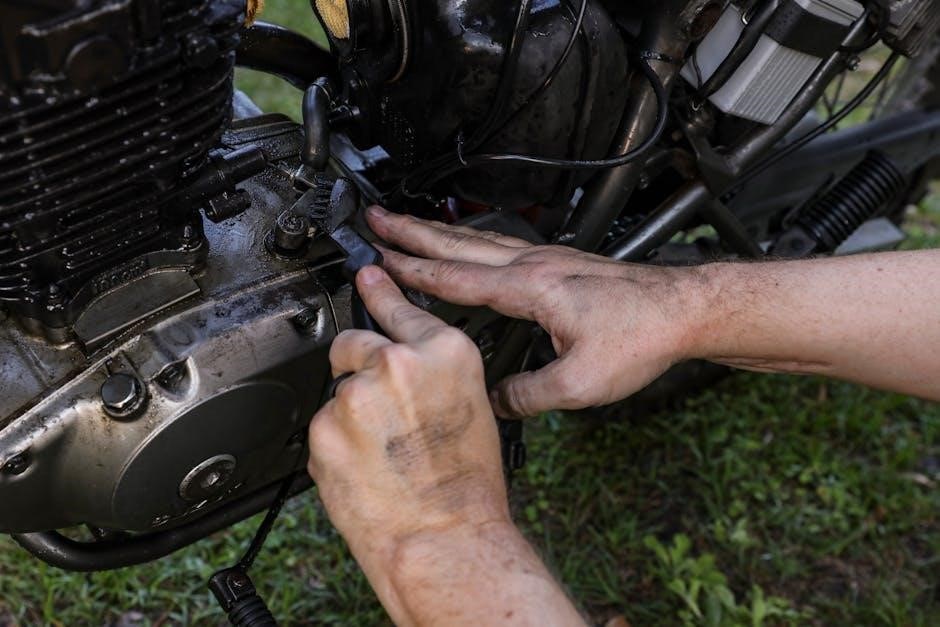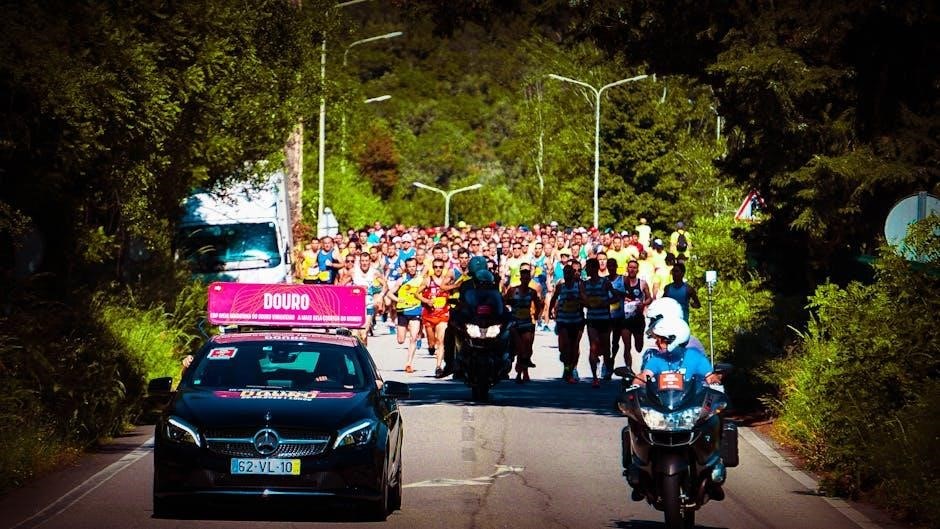Mass Motorcycle Manual: A Comprehensive Guide
This comprehensive guide explores the history of mass motorcycle production‚ from the early pioneers to the modern era. Discover key manufacturers‚ technological advancements‚ and the impact of historical events.
The story of mass motorcycle production begins in the late 19th century‚ a time of rapid innovation and engineering breakthroughs. Before mass manufacturing‚ motorcycles were largely bespoke creations‚ handcrafted and expensive‚ inaccessible to the average person. However‚ as internal combustion engines became more refined and manufacturing processes more efficient‚ the possibility of producing motorcycles on a larger scale emerged.
This introduction will delve into the origins of mass motorcycle production‚ highlighting the key factors that contributed to its rise. We’ll explore the pioneering companies that dared to dream of a world where motorcycles were affordable and readily available. From the early designs and manufacturing techniques to the challenges overcome and the triumphs achieved‚ this section sets the stage for a deeper exploration of the rich history of mass motorcycle production. The story includes engineering and designing history.

Early Pioneers of Mass Motorcycle Manufacturing
This section explores the groundbreaking efforts of the companies and individuals who first ventured into mass motorcycle manufacturing‚ revolutionizing transportation and shaping the industry we know today.
Hildebrand & Wolfmüller (1894)
The earliest factory opened in 1894 by Heinrich and Wilhelm Hildebrand‚ alongside Alois Wolfmüller‚ stands as the genesis of mass motorcycle production. Their Munich-based factory produced over 1‚000 machines in its initial two years‚ each featuring a 1488 cc twin-cylinder four-stroke engine. These German engineers‚ having previously worked with steam engines‚ partnered with Wolfmüller‚ an inventor‚ to create the first powered motorcycle for the masses.
Despite their pioneering efforts‚ the company faced challenges. The motorcycle’s design had limitations‚ and the business struggled to achieve profitability. Though short-lived‚ Hildebrand & Wolfmüller’s contribution as the world’s first series production motorcycle remains a cornerstone in motorcycle history.
Triumph’s Entry into the Motorcycle Market
Triumph‚ initially a bicycle manufacturer based in England‚ ventured into the motorcycle market in 1898‚ marking a pivotal moment in the industry. However‚ it wasn’t until 1902 that Triumph unveiled its first motorcycle model‚ solidifying its presence in the burgeoning market. Their entrance signified a shift as established companies adapted to the rise of internal combustion engines.
Triumph’s commitment to innovation and mass production eventually propelled them to become one of the largest motorcycle manufacturers. The company’s early models paved the way for future advancements and solidified its legacy. Triumph’s journey exemplifies the transition of traditional manufacturers embracing motorized transport. This also set stage for future competition.
Indian Motorcycle Manufacturing Company
The Indian Motorcycle Manufacturing Company‚ founded in 1901‚ holds a significant place in motorcycle history as America’s first mass-produced motorcycle manufacturer. Their emergence marked a turning point‚ showcasing the growing demand for motorized transportation. This also helped establishing the United States as a key player in the global motorcycle market. The company’s commitment to innovation and production paved the way for future American motorcycle brands.
Indian Motorcycle’s early models were instrumental in shaping the industry’s landscape‚ influencing design and performance standards. Their success demonstrated the viability of mass-producing motorcycles and set a precedent for other companies to follow. Indian Motorcycle’s legacy continues to inspire enthusiasts and manufacturers alike.

Impact of World Wars on Motorcycle Production
World Wars significantly increased motorcycle production. Bikes replaced horses for front-line transmissions. Harley-Davidson dedicated over 50% to war efforts. Triumph sold over 30‚000 bikes to allied forces.
Increased Demand During World War I
The First World War triggered a substantial surge in motorcycle production‚ primarily driven by the need for efficient and rapid transport solutions. Motorcycles began replacing horses as the primary method for delivering transmissions and crucial supplies to troops stationed at the front lines. This transition marked a pivotal shift in military logistics‚ highlighting the motorcycle’s newfound importance in warfare.
As the conflict escalated‚ manufacturers worldwide responded to the increased demand‚ ramping up their production capabilities. Harley-Davidson‚ for instance‚ dedicated over 50% of its manufacturing capacity to fulfilling wartime contracts‚ supplying motorcycles to the American military. Similarly‚ Triumph‚ a British manufacturer‚ sold over 30‚000 motorcycles to the Allied forces‚ playing a vital role in supporting their war efforts. The war effort spurred innovation and mass production.
Harley-Davidson’s Wartime Contribution
Harley-Davidson played a crucial role during World War I‚ significantly contributing to the Allied forces’ war effort. The company dedicated over 50% of its manufacturing capacity to producing motorcycles for the United States military. These motorcycles were primarily used for reconnaissance‚ delivering messages‚ and transporting personnel across the challenging terrains of the European theater.
Harley-Davidson’s motorcycles proved to be reliable and durable‚ capable of withstanding the harsh conditions of warfare. Their contribution was so substantial that Harley-Davidson became the largest motorcycle manufacturer in the world after World War I‚ a testament to its wartime production and technological advancements. The company’s involvement in the war not only boosted its production capabilities but also enhanced its reputation for producing high-quality‚ dependable motorcycles. These wartime profits helped solidify their market position and propelled their future success.
Triumph Model H: The “Trusty Triumph”
The Triumph Model H‚ affectionately known as the “Trusty Triumph‚” holds a significant place in motorcycle history‚ particularly for its role during World War I. It was one of the most popular motorcycles of the era‚ with over 57‚000 units manufactured‚ supplied to the Allied forces. The Model H was powered by a reliable 499cc air-cooled‚ four-stroke‚ single-cylinder engine‚ making it a robust and dependable machine for military use.
Its popularity stemmed from its ease of maintenance‚ durability‚ and ability to navigate the challenging terrains of the battlefield. The “Trusty Triumph” was instrumental in delivering messages‚ transporting personnel‚ and performing reconnaissance duties. This model was also among the first mass-produced motorcycles‚ setting a precedent for future large-scale motorcycle manufacturing. Its legacy extends beyond its wartime contributions‚ influencing subsequent motorcycle designs and solidifying Triumph’s reputation as a leading motorcycle manufacturer.
Key Manufacturers and Their Contributions
Explore the pivotal roles of Honda‚ BSA‚ and BMW in shaping motorcycle history through innovation‚ mass production techniques‚ and enduring designs that continue to influence the industry.
Honda’s Mass Production Milestone
Honda’s journey into mass motorcycle production began in 1949 with the introduction of the Dream Type-D‚ marking a pivotal moment in the company’s history and the broader motorcycle industry. This milestone signifies Honda’s commitment to producing affordable‚ reliable motorcycles for the masses‚ transforming transportation. The Dream Type-D served as a foundation for Honda’s subsequent innovations and expansion into global markets.
Reaching the 300 million-unit mark within 66 years of starting motorcycle production highlights Honda’s remarkable success and influence. This achievement underscores the impact of Honda’s mass production strategies and its dedication to quality and customer satisfaction. Honda’s legacy extends beyond mere numbers‚ shaping motorcycle culture and accessibility worldwide.
The company’s ability to adapt and innovate has solidified its position as a leading manufacturer‚ continuously pushing boundaries and setting new standards for motorcycle design and performance.
BSA’s Historical Achievements
BSA‚ or Birmingham Small Arms Company‚ boasts a rich history marked by significant achievements in motorcycle manufacturing. In 1924‚ four BSAs etched their name in motorcycling history by successfully conquering Snowdon‚ showcasing the brand’s durability and performance capabilities. This feat exemplified BSA’s engineering prowess and established its reputation for producing robust and reliable machines.
Beyond motorcycle production‚ BSA ventured into diverse areas‚ including the manufacturing of three and four-wheel cars in 1929. During the 1930s‚ the company repurposed its arms-making equipment‚ demonstrating its adaptability to changing market demands. Additionally‚ BSA acquired the Lanchester Motor Company in 1931‚ further diversifying its portfolio.
These endeavors underscore BSA’s commitment to innovation and its ability to navigate evolving industries while leaving a lasting impact on both motorcycle and automotive history. BSA’s legacy remains a testament to its engineering excellence and its contributions to transportation.
BMW’s Resumption of Motorcycle Production
Following the tumultuous years of World War II‚ BMW faced significant challenges in rebuilding its manufacturing operations. The company’s focus shifted towards restarting production‚ and in 1948‚ BMW triumphantly resumed motorcycle manufacturing‚ marking a pivotal moment in its post-war recovery. This resumption signaled BMW’s commitment to its heritage and its determination to reclaim its position in the motorcycle market.
In 1952‚ BMW further expanded its operations by restarting car production in Bavaria‚ showcasing its diversified capabilities. The company’s automotive range grew in 1955‚ solidifying its presence in the automotive industry.
BMW’s ability to overcome adversity and successfully resume both motorcycle and car production underscores its resilience and its unwavering dedication to engineering excellence. This period of recovery and expansion laid the foundation for BMW’s future success as a leading manufacturer of both motorcycles and automobiles‚ reaffirming its global reputation for quality and innovation.

The Quest for Speed and Performance
This section explores the relentless pursuit of speed and enhanced performance in mass-produced motorcycles. We will examine groundbreaking models and technological advancements that pushed boundaries.
Norton Dunstall 810: Breaking the 12-Second Barrier
The Norton Dunstall 810 stands as a pivotal moment in motorcycle history‚ representing a significant leap in performance for production models. In 1971‚ Cycle World magazine heralded the Dunstall 810‚ a modified Norton Commando‚ as the first production motorcycle to break the 12-second barrier in the quarter-mile. Clocking in at an impressive 11.9 seconds‚ this feat showcased the potential of tuning and refinement in existing motorcycle platforms.
While not directly manufactured by Norton‚ the Dunstall 810 was a readily available modification package‚ transforming the Commando into a speed demon. This achievement highlighted the growing demand for high-performance motorcycles and the ingenuity of aftermarket tuners in pushing the limits of existing designs. The Dunstall 810’s legacy is one of speed‚ innovation‚ and a testament to the enduring appeal of the Norton Commando platform.
The Truce of Speed: Suzuki Hayabusa
The late 1990s witnessed an intense competition among motorcycle manufacturers to produce the fastest production bike. This “speed war” reached its zenith with the arrival of the Suzuki Hayabusa in 1999. Boasting unparalleled power and aerodynamic design‚ the Hayabusa shattered speed records and became an instant icon.
However‚ concerns over safety and potential regulations led to an informal agreement‚ a “truce of speed‚” among manufacturers. This agreement limited the top speed of production motorcycles to approximately 186 mph (300 km/h); The Hayabusa‚ while still a high-performance machine‚ became a symbol of this era‚ marking both the peak of the speed wars and the subsequent shift towards responsible performance. The truce lasted approximately 8 years.

The Future of Mass Motorcycle Production
The future of mass motorcycle production is poised for significant transformation‚ driven by technological advancements and evolving consumer demands. Electric motorcycles are gaining traction‚ promising cleaner and more efficient transportation. Innovations in battery technology and charging infrastructure will be crucial for their widespread adoption.
Furthermore‚ connectivity and advanced rider-assistance systems (ARAS) are becoming increasingly prevalent‚ enhancing safety and rider experience. Automation and robotics are also likely to play a larger role in manufacturing processes‚ improving efficiency and reducing costs. The integration of sustainable materials and environmentally friendly manufacturing practices will be essential for responsible motorcycle production. Ultimately‚ the future lies in balancing performance‚ sustainability‚ and technological innovation to meet the needs of a diverse and evolving market.

